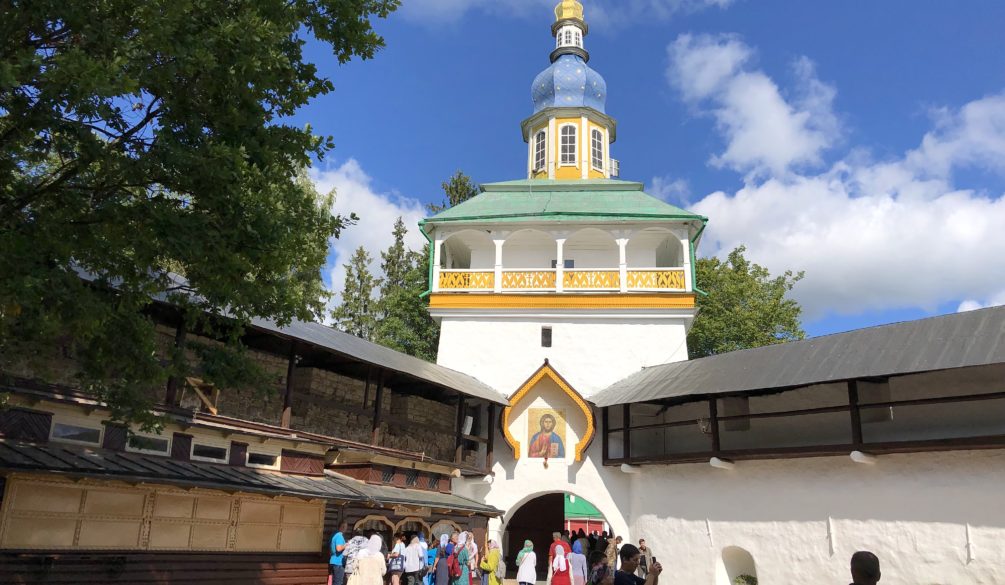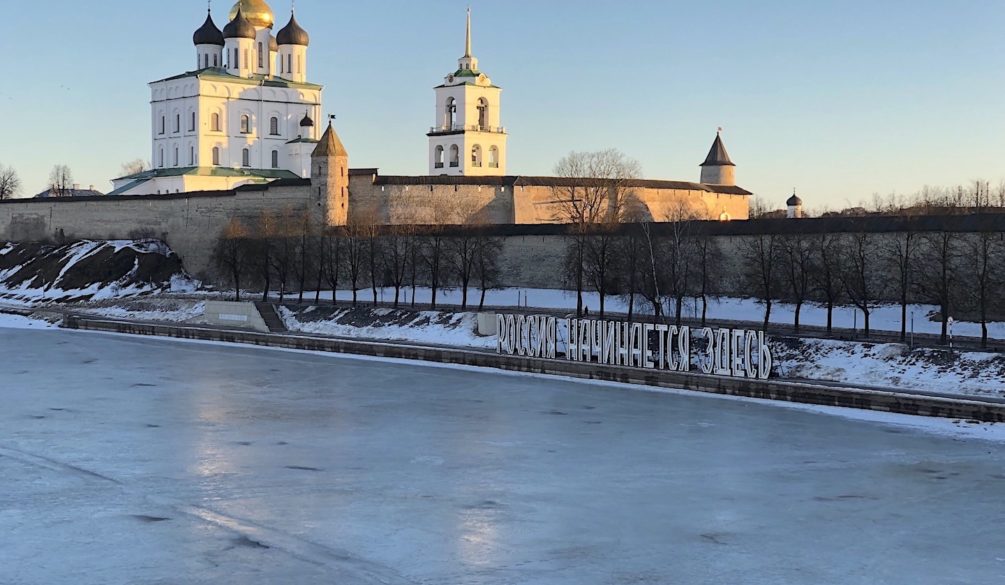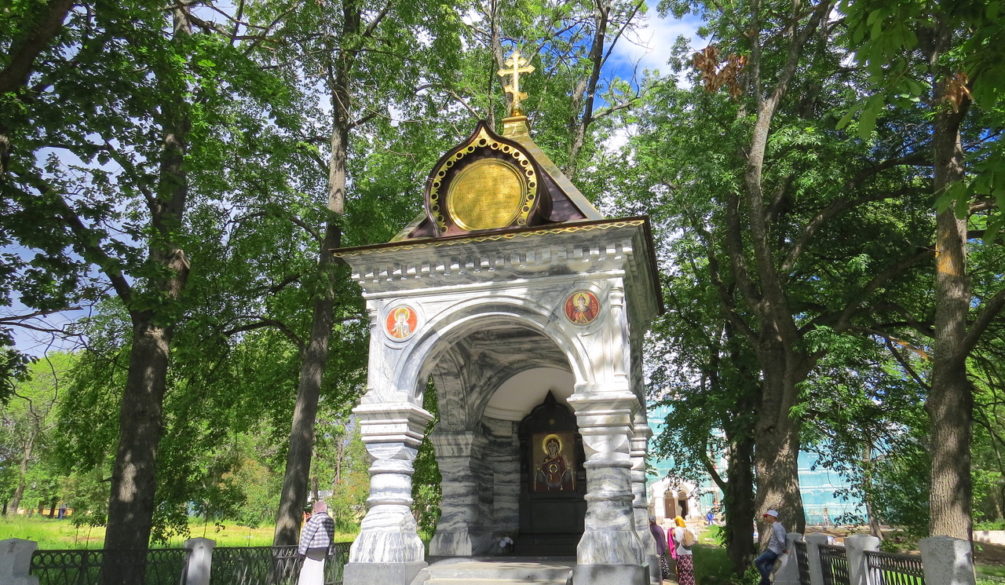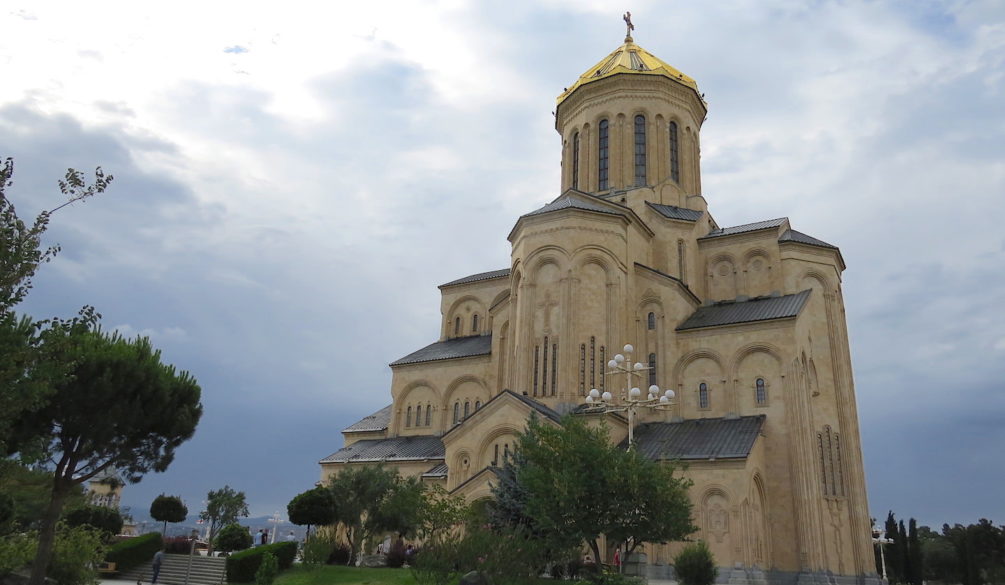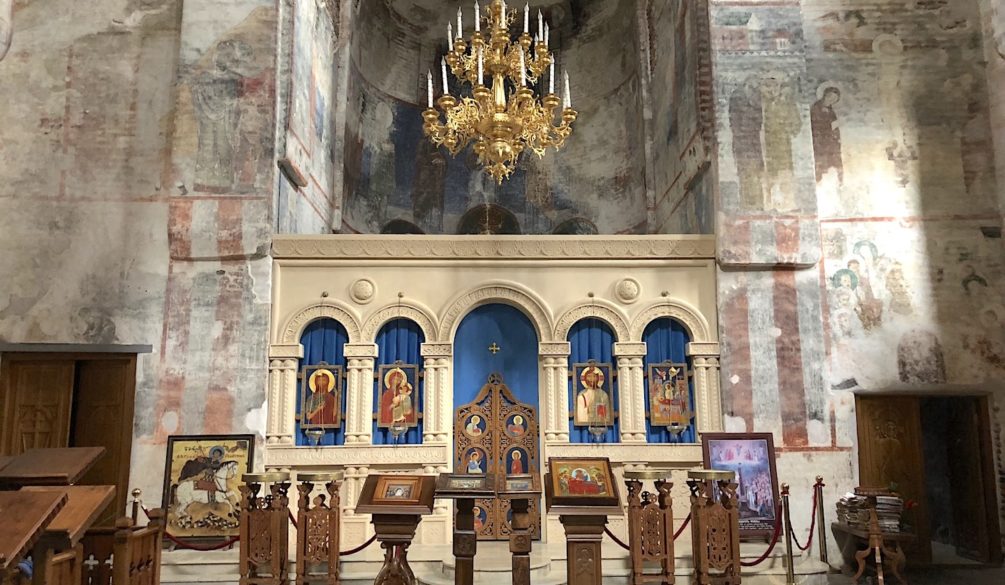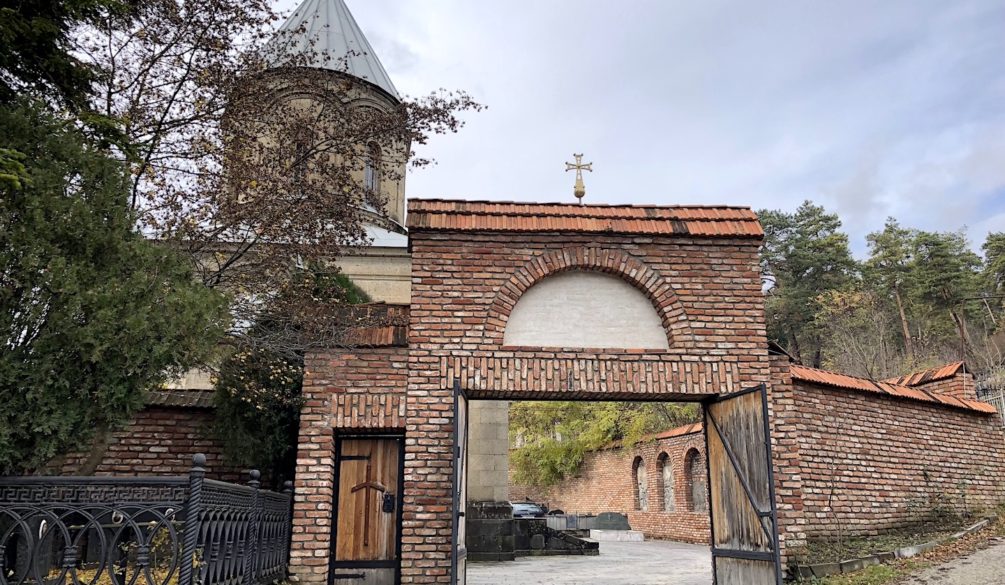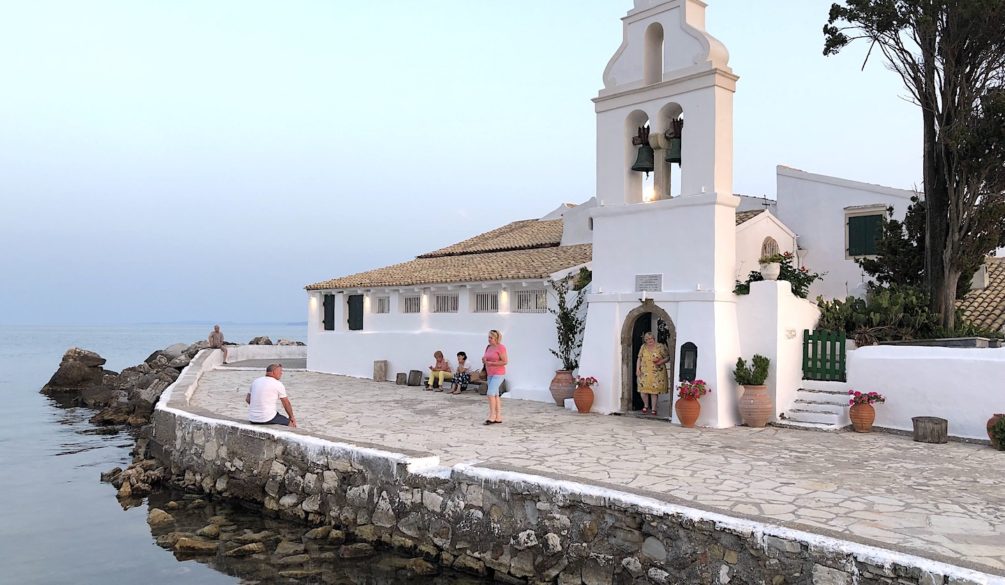2021
Russia Holy Dormition Pskov-Pechersk Monastery August 24, 2019
The monastery in the twentieth century and today
In the twentieth century, the monastery together with the Fatherland had to go through two wars. But the ancient traditions, carefully preserved in the monastery, were not violated even in the most terrible times for Russian monasticism. By the prayers of the Most Pure Mother of God, the Pskov-Pechersk Monastery was assigned to bourgeois Estonia by the providence of God under the 1922 treaty and remained there until 1940, which saved it from general ruin and desecration.
The disasters that befell our Fatherland during the Great Patriotic War did not pass by the monastery. The Refectory and the Fraternal Building, the wall of the St. Michael’s Cathedral were destroyed. Other churches were also hit by artillery fire.
Archimandrite Pimen, the vicar of the monastery from 1949 to 1954, who later became the Patriarch of Moscow and All Russia, was largely responsible for putting the monastery’s economy in order in the post-war years. His work was continued by Archimandrite Alipius, a warrior and artist (1959-1975). In 1960, he began the restoration of the fortress walls and towers (they had been standing uncovered since 1688 after a devastating fire, gradually collapsing).
During the difficult time of the war, the monastery was headed by Abbot Paul (Gorshkov). After the release of Pechora, he was arrested, sentenced to 15 years and died in a prison hospital at the age of 80. For many years, tourists who visited the monastery were told about its alleged cooperation with the Nazis. Only after 52 years, Abbot Paul was rehabilitated. Then, in the first year of the war, the brethren did not accidentally choose him as their governor. Thanks to the subtle and clever line of behavior he chose with the occupation regime, the monastery with all its values and shrines was preserved, the brethren were preserved. Moreover, trusting in the mercy of God, he strengthened others with his faith, organized food aid to prisoners of the Red Army in the camp point No. 134 of Pskov, the sick and elderly of the Pskov Home for the Disabled and the poorhouse on Zavelichye. There is also evidence that during the war, Soviet scouts took refuge in the monastery caves. One of them, when visiting the monastery in 1984, personally confirmed this fact.
So the holy monastery-fortress and in the last war remained an unquenchable lamp of the Orthodox faith, a reliable support for our compatriots to survive in this difficult time for the whole country.
The monastery was also famous in peaceful years for the spiritual exploits of its inhabitants, whose prayers do not impoverish the mercy of God to those who seek Heavenly consolation at the Pechersk shrines. Throughout the entire existence of the monastery, the fire of senile service has not been extinguished in it. All those who came for spiritual comfort and advice found them in conversations with the great prayer books.
During a visit to the Pechersk Monastery by the family of Tsar Nicholas II, the latter had a spiritual conversation with the elder Theodosius, who was then working in the monastery.
For more than 60 years, Hieroschemimonk Simeon (Zhelnin) served God and people, spiritually nurturing not only the monastery’s brethren, but also numerous laypeople and pilgrims who came to him for spiritual advice. A separate book has been published about his life, in which the reader will find many testimonies about the miraculous prayerful help of the elder. On April 1, 2003, Hieroschemimonk Simeon was glorified in the face of saints.
Schiarchimandrites Agapiy (Agapov), Pimen (Gavrilenko) continued the feat of senile service in the 60s and 70s.
After the Great Patriotic War, the Pskov-Pechersk Monastery was visited by the elders from Valaam, who had been transported from the holy island to Finland before the war. Hieroschemonachs Michael (Pitkevich), Luke (3emskov) and other elders were like a spiritual bridge connecting the Old Valaam and the holy Pechersk monastery. Metropolitan Veniamin (Fedchenkov) spent the last years of his life in the monastery.
The monastery continues to be decorated all these years. In the 80s, with the blessing of Metropolitan John (Razumov), the vicar Archimandrite Gabriel (Steblyuchenko 1975-1988), now Archbishop of Blagoveshchensk and Tynda, carried out major restoration work: the painting of the temple walls was updated, the restoration of the monastery walls, which was started under Archimandrite Alipia, was completed, a new fraternal building was built, a chapel in honor of the Monk-Martyr Cornelius was built in the St. Nicholas Church, the premises were renovated bakeries and libraries.
Thanks to the zeal of the next abbot (1988-1992), Archimandrite Pavel (Ponomarev), now Metropolitan of Ryazan and Mikhailovsky, the monastery’s library, which was kept in Tartu, was returned to the monastery, new buildings of the hospital, icon-restoration and sewing workshops were built, a Mercy House for lonely elderly people was built in the city, 100 hectares of arable land were returned to the monastery.
The viceroy, Archimandrite Roman (Zherebtsov), continued the reconstruction of the monastery buildings and churches, and under his care built a wooden fraternal building and began covering the fortress walls and towers with copper.
The vicar of the monastery from 1995 to 2018, Archimandrite Tikhon (Secretarev) He continued the pious tradition of his predecessors in preserving the monastic charter and improving and decorating the monastery. The construction of the fraternal stone building near the tower of the Lower Lattices with a bath and laundry has been completed, the work on covering the fortress walls with copper has been completed, the construction of the economic complex is underway, the domes of the temples, the paintings on the facade of the Assumption Church have been restored, and the restoration of the Mikhailovsky Church has been carried out.
Its centuries-old traditions are carefully preserved in the monastery. With the blessing of His Holiness, His Holiness Patriarch Alexy II of Moscow and All Russia, the locally venerable Fathers Mark, Jonah, and the Venerable Mother Vassa were added to the All-Russian Holy Places. Since 1994, the monastery has been celebrating the memory of the Holy Fathers of Pskov-Pechersk in the 4th week after Pentecost, and in 1998, the celebration in honor of the miraculous icon of the Mother of God “Emotion”, performed in the 7th week after Easter, was restored. For the first time in many years (since the beginning of the twentieth century) in July 2000, the miraculous icon of the Mother of God ” Tenderness” Pskov-Pecherskaya visited Pskov at the consecration of the chapel in honor of St. Olga.
The monastery continues its catechetical and publishing activities.
On the shore of Lake Pskov, the monastery opened a Priozerny Skete. Also in the monastery there is a skete on the shore of Lake Malsky.
On June 1, 2012, a Pilgrimage center was opened on the territory of the former military unit, which can accommodate a large number of people who want to pray in the monastery and worship its shrines. A guided tour service is also available.
All the spiritual and educational activities of the monastery are led by His Eminence Tikhon, Metropolitan of Pskov and Porkhov, Holy Archimandrite of the Holy Dormition Pskov-Pechersk Monastery with the Spiritual Cathedral, blessing and sanctifying the works of the monks.
And may God grant that, through the intercession of the Most Pure Theotokos, the tradition of the Pechersk asceticism may not be suppressed, and that the monastery may continue to be the bright embodiment of the ideal of Orthodox Holy Russia.
2021
Russia Pskov 25-26 February 2019
The House of the Holy Trinity – so since ancient times called the glorious city of Pskov. The appearance of one of the first Orthodox cities in Russia is closely connected with the Holy Trinity Cathedral. It was here, after the holy baptism in Constantinople in 957, that Princess Olga saw three light-bearing rays illuminating from the sky the elevation at the confluence of two rivers – the Pskov and the Great. She prayed for a long time and prophetically said that “in this place the city will be great, glorious and abundant”, and ordered to build a church in the name of the Holy Life-Giving Trinity
Every year, the day of memory of the Holy Equal-to-the-Apostles Princess Olga of Russia on July 24 is celebrated as a temple and citywide holiday with a large gathering of people. Divine Liturgies are served in all the churches of the city on July 24, and at the end of the service, Religious Processions gather from all the churches and go to the Cathedral Square in the Kremlin, for a Solemn prayer service of the Bishop. This is one of the main events of the Pskov Diocese and for several years the Processions have become a good tradition.
The revered shrine of the church – cancer with the relics of the saints: the blessed Princes Vsevolod-Gabriel, Dovmont-Timothy, St. Blas. St. Nicholas the Fool for Christ’s sake, and St. Nicholas the Fool for Christ’s sake. Joasaph the Abbot of Snetogorsky, as well as the Miraculous Icons of the Mother of God.
Every day, the Divine Liturgy, other divine services, and the sacraments of the Holy Spirit are performed here. Orthodox Churches, prayers at the shrine with Holy relics and Miraculous icons.
The whole life of the Pskov people is filled with the Orthodox faith. And this faith was strengthened with the birth of monastic life.
The first monastery appeared in the Mirozhsky monastery in 1156. Gradually, there were more and more monasteries – Snetogorsky, Spaso-Eliazarovsky, Krypetsky monasteries, and Nikandrova deserts. Life in these abodes is now being revived. The Pechersk and Svyatogorsky monasteries became a place of special pilgrimage for Orthodox people.
In the life of every Orthodox person, at least once there is a secret desire to visit the holy places. Every pilgrim who comes to the Pskov land finds a special spiritual mood. The primeval nature, the silence, the holy springs, the prayer of the monks, the conversation with the priest-all this gives you the opportunity to look inside yourself and find unity with God.
A truly blessed land.
2021
Russia Valaam Spaso-Preobrazhensky Monastery June 22-25, 2019
There are monasteries in the Russian land whose wondrous light attracts pilgrims from all over the world: the Trinity-Sergius Lavra, Optina of the Deserts, Diveevo… In this series, Balaam occupies a special place. Surrounded on all sides by water, remote from the worldly bustle, it seems to be created for a quiet, contemplative monastic life.
Located in the northern part of Lake Ladoga, 22 km from the mainland, the Valaam archipelago has about 50 islands with a total area of 36 square kilometers, the largest of them is the island of Valaam (27.8 square kilometers), next to it are located about. Skytsky, Predtechensky Island, Yemelyanovsky Island and many other small islands. The distance to the nearest Karelian city of Sortavala (old name Serdobol) is 42 km, to Priozersk-about 60 km, to St. Petersburg-more than 220 km.
The coastline of Valaam is cut by numerous straits, channels and bays, which gives it a special attraction, distinguishing it from many other Ladoga islands. The water area of the archipelago, due to the structure of the lake’s currents, is least affected by the waters of the tributaries and can be considered as a reference for the central part of Ladoga.
The Valaam archipelago has a rare and amazing beauty of nature. On a relatively small territory, there are about 480 species of plants inherent in various natural areas, more than 200 species of birds are found, moose, hares, squirrels, and foxes live. On the deserted islands of the archipelago, you can see the rookeries of the Ladoga seal listed in the Red Book, here you can catch salmon, palia, whitefish, grayling and other valuable fish species.
The sheer cliffs that take on the mighty Ladoga waves, and the quiet peace of the inland lakes, the age-old firs and pines that resist the cold winds, and the discreet beauty of the bright alleys and gardens, the harsh grandeur of the pristine northern nature and the originality of the architectural ensembles — all this gives Valaam a unique appearance of one of the most beautiful islands in the world.
But the earthly beauty of these places is also a visible reflection of the beauty of the unearthly, spiritual. For all Orthodox people Valaam is unthinkable without its ancient monastic monastery, which for centuries was the spiritual center of Orthodox Russia and was rightfully called Northern Athos.
Modern historians date the first mention of the island of Valaam to 800 BC. At that time, there was a huge idolatrous temple on the island, where human sacrifices were offered to the gods Veles and Perun. This is how the ancient one could find it Balaam the Apostle Andrew The First-Called. Monastic tradition says that the holy Apostle Andrew The first-Called, the enlightener of the Scythians and the ancestors of the Slavs, arrived from Kiev to Novgorod, along the Volkhov River reached Lake Ladoga, and then-Valaam, where he blessed the mountains on the islands with a cross or an apostolic rod. This tradition is recorded on the first pages of the “Tale of Bygone Years” or the Chronicle of St. Nestor (the beginning of the XII century).
Tradition tells us that it was the pagan priests who first listened to the apostle’s sermon and received baptism, and then destroyed the temples with their own hands. On the site of the destroyed idols, the disciples of the Apostle Andrew installed a stone cross, and after centuries, the brothers of the Valaam monastery entered their “way of the cross”.
2021
Georgia July 4-14, 2019
Pilgrimage tours to Georgia are primarily an opportunity to relax your soul, touch the great Orthodox shrines and be spiritually reborn. Of course, this is also an opportunity to see many interesting places and visit fascinating excursions. The desire of pilgrims to visit Georgia and pray in places where believers have been praying for several centuries in a row is not accidental. After all, Georgia was one of the first to adopt Christianity and is deservedly considered one of the world’s main treasures of the Orthodox faith. Georgia adopted Christianity from the very Apostle Andrew the First-Called, who brought the faith to the territory of Iberia (modern Georgia) already at the beginning of the first century.
According to Orthodox traditions, the Mother of God chose Georgia as one of her four destinies. In Georgia, the image of the Virgin Mary, brought by the Apostle Andrew, is kept-one of the main shrines of the Orthodox faith. On the territory of modern Georgia, such great companions of the faith preached: Simon the Canaanite, the Apostles Matthew and Bartholomew.
In the Svetitskhoveli temple in Mtskheta, the chiton of Jesus Christ is kept – a great miracle-working treasure of Christianity.
Christianity has had a great influence not only on the culture and customs of Georgia, but also on its architecture. They say that architecture is the soul of the country, depicted in stone. And when you see Georgia, you realize that this is really true. The churches, temples and monasteries of Georgia are striking in their simplicity, and at the same time grandeur. Some of the most beautiful temples of Georgia that you can see during the pilgrimage: Bolnisi Basilica, Ninotsminde Cathedral, Jarvi Temple, Tsromi Church, Svetitskhoveli Temple and others.
2021
Georgia August 21, 2019
Pilgrimage tours to Georgia are primarily an opportunity to relax your soul, touch the great Orthodox shrines and be spiritually reborn. Of course, this is also an opportunity to see many interesting places and visit fascinating excursions. The desire of pilgrims to visit Georgia and pray in places where believers have been praying for several centuries in a row is not accidental. After all, Georgia was one of the first to adopt Christianity and is deservedly considered one of the world’s main treasures of the Orthodox faith. Georgia adopted Christianity from the very Apostle Andrew the First-Called, who brought the faith to the territory of Iberia (modern Georgia) already at the beginning of the first century.
According to Orthodox traditions, the Mother of God chose Georgia as one of her four destinies. In Georgia, the image of the Virgin Mary, brought by the Apostle Andrew, is kept-one of the main shrines of the Orthodox faith. On the territory of modern Georgia, such great companions of the faith preached: Simon the Canaanite, the Apostles Matthew and Bartholomew.
In the Svetitskhoveli temple in Mtskheta, the chiton of Jesus Christ is kept – a great miracle-working treasure of Christianity.
Christianity has had a great influence not only on the culture and customs of Georgia, but also on its architecture. They say that architecture is the soul of the country, depicted in stone. And when you see Georgia, you realize that this is really true. The churches, temples and monasteries of Georgia are striking in their simplicity, and at the same time grandeur. Some of the most beautiful temples of Georgia that you can see during the pilgrimage: Bolnisi Basilica, Ninotsminde Cathedral, Jarvi Temple, Tsromi Church, Svetitskhoveli Temple and others.
2021
Georgia-Monastery of the Nativity of the Most Holy Our Lady of Easter 2019
Pilgrimage tours to Georgia are primarily an opportunity to relax your soul, touch the great Orthodox shrines and be spiritually reborn. Of course, this is also an opportunity to see many interesting places and visit fascinating excursions. The desire of pilgrims to visit Georgia and pray in places where believers have been praying for several centuries in a row is not accidental. After all, Georgia was one of the first to adopt Christianity and is deservedly considered one of the world’s main treasures of the Orthodox faith. Georgia adopted Christianity from the very Apostle Andrew the First-Called, who brought the faith to the territory of Iberia (modern Georgia) already at the beginning of the first century.
According to Orthodox traditions, the Mother of God chose Georgia as one of her four destinies. In Georgia, the image of the Virgin Mary, brought by the Apostle Andrew, is kept-one of the main shrines of the Orthodox faith. On the territory of modern Georgia, such great companions of the faith preached: Simon the Canaanite, the Apostles Matthew and Bartholomew.
In the Svetitskhoveli temple in Mtskheta, the chiton of Jesus Christ is kept – a great miracle-working treasure of Christianity.
Christianity has had a great influence not only on the culture and customs of Georgia, but also on its architecture. They say that architecture is the soul of the country, depicted in stone. And when you see Georgia, you realize that this is really true. The churches, temples and monasteries of Georgia are striking in their simplicity, and at the same time grandeur. Some of the most beautiful temples of Georgia that you can see during the pilgrimage: Bolnisi Basilica, Ninotsminde Cathedral, Jarvi Temple, Tsromi Church, Svetitskhoveli Temple and others.
2021
Greece Corfu Island July 2019
The church of St. Spyridon of Trimifunt on the island of Corfu, in the city of Kerkyra.
The capital of the island of Kerkyra is considered one of the most beautiful cities in Greece. Today, Kerkyra is the spiritual, cultural, and economic center of not only the island of the same name, but also of all the Ionian Islands. The city is unique in its diversity, it has retained the stamp of various cultures: ancient Greek, Ancient Roman, Byzantine; here, various architectural styles are intricately and harmoniously intertwined: Venetian, French, English, but at all times it remained Greek in spirit.
The current church of St. Spyridon is located in the midst of the picturesque narrow,” two donkeys”, in the words of Gerald Durrell, the streets of the old town. The architecture of the building is typical of the temples of the Ionian Islands. A high snow-white bell tower with a red dome and a clock rises above two or three-story buildings. It is a great landmark for visiting pilgrims. The church of St. Spyridon was considered the richest in the East, donations to the church were made not only by Orthodox, but also by Catholic Christians. Numerous contributions were made by the Russian Empress Catherine II and her son Emperor Paul I.
The mural painting differs from the painting in Greek temples and rather resembles Italian frescoes. Undoubtedly, the influence of Venice is felt. Huge gold and silver panicadils, a marble iconostasis, unusual-looking icons-medallions in gold frames on the vault. They represent scenes from the life of the Saint, the Evangelists, and other similar themes and images. The ceiling of the temple was made by Panagiotis Doxaras (1662-1729), one of the founders The Ionian School of Art, which was influenced by the Renaissance. The artist studied in Rome and Venice and was a great admirer of Tintoretto, Titian, and Veronese. In 1750-1755, a number of works were performed by Spiridon Sperantsas. The original icons and other church paintings by Doxaras were destroyed by the dampness, and their place was taken by copies made by Nikolaos Postpotis in 1851-1852.
The silver sarcophagus of St. Spyridon, made in 1867 by special order in Vienna, is located in a small chapel to the right of the altar. There are a lot of churches on the island, which emphasizes the sincere deep religiosity of its inhabitants, but they have special feelings for St. Spyridon, who is considered the main patron of the island, and his relics are the most valuable treasure. It is enough to stay in the church where the holy relics rest for a few hours to understand how much the Saint is revered here. It seems that the temple is the center of attraction for all the inhabitants of the island. Throughout the day, it is never empty for a minute. And it’s not just about the many pilgrims. The locals come here with their joys and sorrows, asking for help and thanking the Saint for his mercy. The temple has two side doors opening onto parallel streets, and, hurrying about their business, the townspeople, passing through the temple, hurry to witness their love for him. For many of them, the morning begins with the fact that they go to venerate the relics, put a candle, ask for blessings for the upcoming day. After the Liturgy, a moleben is served in the church, and the shrine with the relics of the Saint is opened (sometimes it is opened at five o’clock in the evening). There is a huge queue of those who want to venerate the whole-bearing relics. Two priests are constantly reading notes. The number of children and young people in the temple is amazing. Children from an early age know how to behave in a holy place, where to put a candle, how to cross themselves. Old men and women who are in no hurry to go anywhere sit in the temple for hours in awe, watching what is happening. Candles are also sold here at the entrances to the temple. In addition to the usual candles, you can buy huge, almost the height of a person. They are placed on special candlesticks on the street in front of the entrance.
For centuries, the faith of the inhabitants of the island in their Saint has not weakened — there is no family here that could not tell the story of how Saint Spyridon helped them or their loved ones. When they say “Saint”, everyone understands that they are talking about Saint Spyridon. Many Greeks call it the name of their children, in Kerkyra Spiro (Spyridon) is the most common male name. This is a tribute to the local residents to the most revered Saint here, but St. Spyridon helps not only “his own”, he helps all who need his heavenly protection, all who turn to him with faith, for them all, he stands at the Throne of God. Thousands of believers from all over the world come to venerate the relics of the Saint.
Despite the fact that all the miracles of St. Spyridon are officially recognized by the church and are documented in the chronicles of the island of Cyprus, it is very difficult for a modern person to believe in them. The body of Saint Spyridon has a constant temperature: 36.6 degrees. He grows hair and nails. These amazing relics-they weigh as much as the body of an adult man and miraculously do not lose the properties of living flesh, have the temperature of the human body and retain softness. There is no other explanation than a miracle. Scientists from all over the world tried to study the phenomenon of the incorruptible relics of Saint Spyridon, and the church did not prevent them. However, biophysicists and biochemists, having studied the relics of the saint, only spread their hands. There is no other explanation, other than a miracle, for what any Orthodox visitor to the church in Corfu can see. It is also a miracle that the patron saint of the wanderers, st. Spiridon himself to this day does not cease to “wander”, helping everyone who turns to him with faith in prayer.
Services every day. The Liturgy begins on weekdays at about 8.30, on Sunday-closer to 9.00. Before it, the Hours and Matins. In the evening, the service is at 19.00. The relics are opened immediately after the Liturgy closer at 10.00 and in the evening in the interval from 17.30 to 18.30. During the day – as groups of pilgrims arrive.







